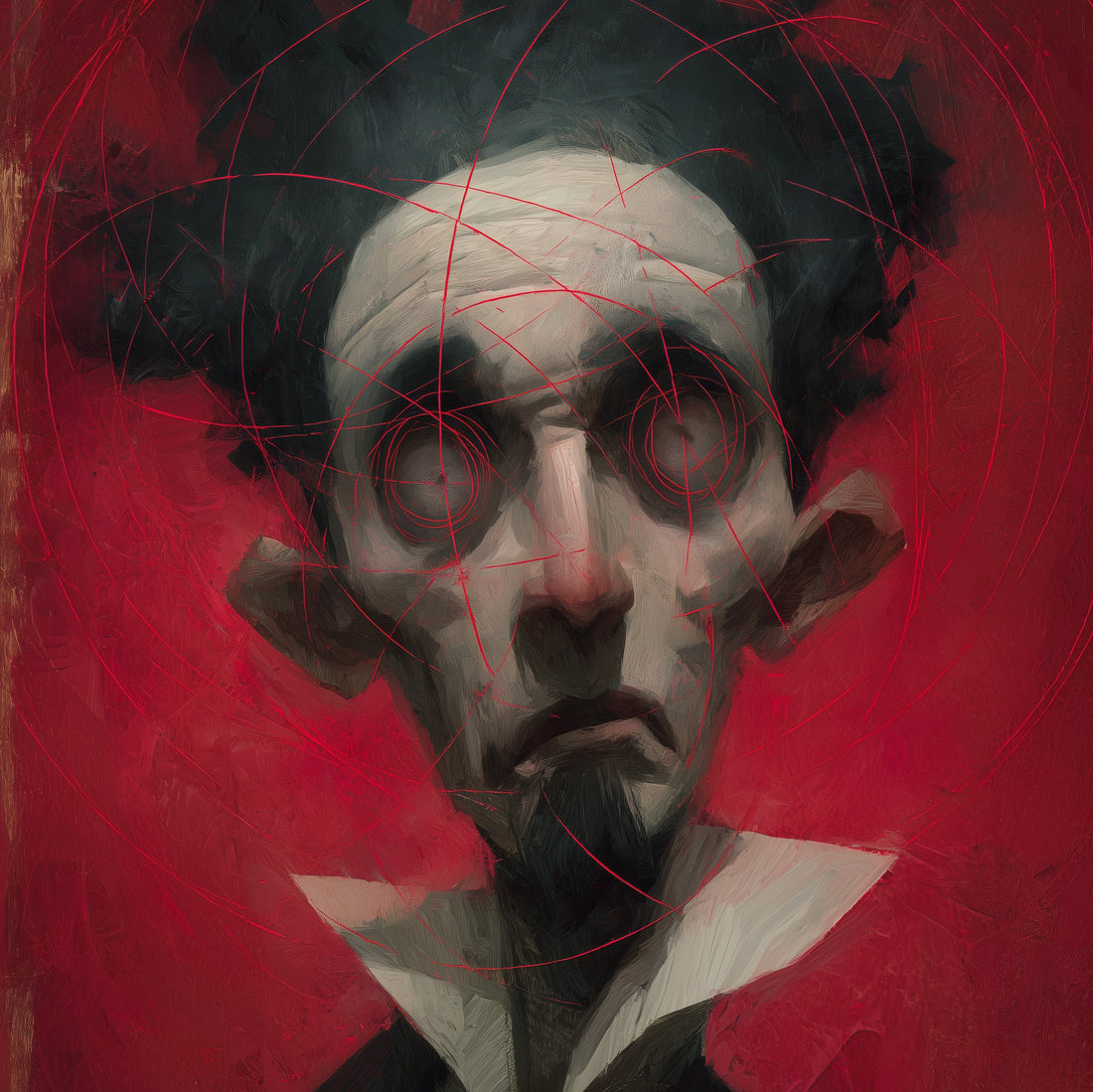
When Gothic Meets Geometry: The Haunting Beauty of Modern Dark Portrait Art
ChristianShare
You know that feeling when you stumble across a piece of art that makes you stop dead in your tracks? That's exactly what happened when I first encountered this mesmerizing blend of classical gothic portraiture and modern geometric chaos. It's like someone took a Victorian gentleman's portrait and ran it through a digital nightmare – and honestly, I'm here for it.
The Renaissance of Dark Art in Digital Spaces
Gothic art isn't dead – it's just gotten a serious upgrade. While traditional gothic artwork focused on religious themes and architectural grandeur, today's artists are pushing boundaries in ways that would make medieval monks clutch their prayer beads. This particular piece screams modern gothic aesthetic with its bold use of crimson geometric overlays against a hauntingly pale subject.
Speaking of gothic evolution, if you're curious about how we got here, check out when gothic art actually started – it's a fascinating journey from cathedral architecture to contemporary wall art.
IMO, there's something deeply satisfying about watching classical art forms evolve. The artist here has managed to capture that timeless gothic melancholy while adding layers of contemporary complexity that speak to our digitally-obsessed generation. It's like the portrait is caught between two worlds – the romantic darkness of the past and the stark, analytical present.
Why Red? The Psychology Behind the Color Choice
Ever wonder why red features so prominently in dark art? It's not just because it looks cool (though it definitely does). Red triggers primal responses – it's the color of blood, passion, danger, and power. When you overlay geometric red lines across a somber portrait, you're creating visual tension that's almost impossible to ignore.
The psychological impact is immediate and visceral. Your brain processes the familiar human form first, then gets hit with these sharp, mathematical intrusions. It's unsettling in the best possible way – like finding order in chaos, or chaos in order, depending on how you look at it.
Geometric Chaos: When Math Meets Madness
Those red geometric lines aren't just thrown on randomly (despite what your art teacher might have told you about "happy accidents"). They follow specific patterns that create depth and movement across the canvas. The circular motifs around the eyes draw your attention to the subject's haunting gaze, while the angular lines fracture the face into geometric segments.
This technique reminds me of glitch art or digital distortion, but with a distinctly gothic twist. It's as if the portrait is experiencing some kind of existential crisis – breaking apart and reforming simultaneously. The lines could represent:
- Psychological fragmentation
- The intersection of human and digital
- Sacred geometry overlaying mortal flesh
- The breakdown of classical artistic boundaries
If you're drawn to this kind of psychological horror artwork, you might love browsing the macabre and morbid poster collection – it's full of pieces that explore similar themes of mental fragmentation and dark psychology.
Technical Brilliance Hidden in Plain Sight
What really gets me excited about this piece is the technical execution. The artist has maintained realistic skin tones and facial structure while integrating these bold geometric elements seamlessly. It's not easy to balance such contrasting visual languages without the whole thing falling apart.
The color palette is deliberately restricted – muted grays and flesh tones for the portrait, with that striking red for the geometric overlay. This restraint prevents the piece from becoming visual chaos while ensuring the red elements pack maximum punch. Smart move, honestly.
The Modern Gothic Aesthetic Revolution
Gothic art has always been about transformation – whether spiritual, emotional, or aesthetic. This contemporary approach takes that tradition and runs it through a digital blender (in the best way possible). We're seeing artists worldwide embrace this fusion of classical gothic elements with modern design principles.
The result? Wall art that speaks to both art history nerds and contemporary design enthusiasts. You can hang this in a minimalist apartment or a full-blown gothic mansion, and it'll work either way. That's the beauty of this hybrid aesthetic – it's versatile enough for modern spaces while maintaining that delicious dark edge we crave.
For a perfect example of this modern-meets-classical approach, check out the Dark Angel Art Print – it captures that same blend of traditional gothic themes with contemporary design sensibilities.
Why This Style Works in Contemporary Spaces
Let's be real – pure traditional gothic art can feel a bit heavy-handed in modern homes. Unless you're living in a castle (lucky you!), those massive religious paintings might overwhelm your living room. But pieces like this? They bring gothic sophistication without the medieval baggage.
The geometric elements add a contemporary edge that makes the artwork feel current and relevant. It's gothic for the Instagram generation – dark, mysterious, but also visually dynamic and shareable. FYI, this is exactly the kind of piece that performs well on social media :)
The Psychology of Disturbing Beauty
There's something fascinating about our attraction to psychologically unsettling artwork. This portrait manages to be simultaneously beautiful and disturbing – the subject appears dignified yet fractured, classical yet futuristic. It's visual cognitive dissonance at its finest.
Why do we love being unsettled by art? Maybe it's because safe, pretty artwork doesn't challenge us. This piece forces you to confront questions about identity, technology, and the human condition. The geometric overlay could represent how digital technology is reshaping our perception of humanity – literally fragmenting our understanding of what it means to be human.
The Uncanny Valley Effect in Static Art
You've probably heard of the uncanny valley in robotics – that creepy feeling when something looks almost human but not quite. This artwork creates a similar effect through its geometric distortion. The subject looks human, but those red lines suggest something else entirely – a being caught between realities.
This psychological tension is what makes the piece so compelling. Your brain wants to resolve the visual conflict, but the artist has deliberately made that impossible. It's unsettling, sure, but it's also brilliant.
If you're fascinated by this kind of psychological horror in art, the Horror Art Print collection offers more pieces that explore the darker corners of the human psyche.
Practical Considerations for Dark Art Collectors
If you're thinking about adding pieces like this to your collection (and you should!), there are some practical considerations worth mentioning. Modern gothic artwork requires specific display conditions to achieve maximum impact.
Lighting is crucial – too bright, and you lose the moody atmosphere; too dim, and the geometric details disappear. I've found that subtle, warm lighting works best for this style. You want enough illumination to appreciate the technical details without killing the gothic vibe.
Where to Display Contemporary Gothic Art
These pieces work exceptionally well in:
- Home offices (nothing says "creative professional" like tasteful dark art)
- Bedrooms (for those who appreciate beauty in darkness)
- Living rooms as statement pieces
- Gallery walls mixed with other contemporary works
The key is balance. One striking piece like this can anchor an entire room's aesthetic without overwhelming the space. For inspiration on creating the perfect gothic gallery wall, browse through the complete dark art poster collection to see how different pieces can work together.
Surrealism Meets Gothic: A Perfect Marriage
This geometric overlay technique actually has deep roots in surrealist tradition – the idea of fragmenting reality to reveal deeper truths. The difference here is that instead of melting clocks or floating objects, we get mathematical precision applied to human features.
It's like whimsical surrealism with a darker edge. The whimsy comes from the unexpected geometric patterns, while the darkness emerges from the subject's haunting expression and the blood-red color choice. If you're drawn to this blend of surreal and gothic, definitely explore the Whimsical Surrealism collection for more pieces that play with reality in equally compelling ways.
Victorian Influences in Modern Context
There's definitely a Victorian gothic influence in the subject's formal attire and dignified bearing. It reminds me of those haunting daguerreotypes from the 1800s, but with a distinctly 21st-century twist. This is exactly the kind of evolution we discuss in Victorian vs Modern Gothic Art – how traditional themes get reimagined for contemporary audiences.
The Future of Gothic Art
What excites me most about pieces like this is how they point toward the future of gothic aesthetics. We're not just recycling medieval themes – we're evolving them, questioning them, and making them relevant for contemporary audiences.
The integration of digital design elements with classical portrait techniques suggests exciting possibilities. What happens when AI starts creating gothic art? How will virtual reality change our relationship with dark aesthetics? This piece feels like a preview of those conversations.
Modern gothic art isn't about living in the past – it's about bringing the past's most compelling elements into dialogue with the present. The result is artwork that feels both timeless and urgently contemporary.
Building Your Dark Art Collection
If this piece has sparked your interest in contemporary gothic artwork, you're probably wondering where to start building a collection. The beauty of modern dark art is its versatility – you can mix and match different styles and themes to create something uniquely yours.
Consider starting with a few key pieces that represent different aspects of gothic aesthetics:
- A portrait piece like this one for psychological depth
- Something from the Bones, Skulls, Skeletons collection for classic gothic symbolism
- A piece from Monsters & Creatures to add fantastical elements
The key is creating a collection that tells a story – your story about what darkness and beauty mean to you.
Final Thoughts: Why This Matters
Look, I could geek out about geometric overlays and color psychology all day, but here's the bottom line: art should move you. This piece succeeds because it doesn't just hang prettily on a wall – it engages, challenges, and rewards closer inspection.
Whether you're a longtime gothic art enthusiast or someone just discovering the beauty of darker aesthetics, pieces like this represent everything exciting about contemporary art. They honor tradition while pushing boundaries, create beauty while embracing darkness, and prove that gothic art is very much alive – it's just gotten a lot more sophisticated.
So next time someone tells you gothic art is outdated, show them this. The darkness isn't going anywhere – it's just learning new tricks :)


























